Alibertia patinoi
Alibertia patinoi, commonly known as borojó, is a small (2-5m), dioecious tropical rainforest tree. It is one of the few of the family Rubiaceae that has edible fruit. It grows in the northwest area of Colombia in the Chocó Department and in the Esmeraldas Province of Ecuador, in areas of high humidity and temperature. Borojó is an Emberá word meaning: boro = head, jo = fruit - head-shaped fruit, or round, globulous fruit.[1][2] The species has also been reported from Panamá, Venezuela and Costa Rica.[3]
| Borojó | |
|---|---|
 | |
| Scientific classification | |
| Kingdom: | Plantae |
| Clade: | Tracheophytes |
| Clade: | Angiosperms |
| Clade: | Eudicots |
| Clade: | Asterids |
| Order: | Gentianales |
| Family: | Rubiaceae |
| Genus: | Alibertia |
| Species: | A. patinoi |
| Binomial name | |
| Alibertia patinoi (Cuatrec.) Delprete | |
| Synonyms | |
| |
Growth
Alibertia patinoi has grey-brown bark and sometimes has two or three smaller trunks as well as one main one. It needs high humidity (over 85%) and temperature (an average of at least 25 °C) to thrive, though it can tolerate brief frosts as well as floods.[4]
Fruit
The fruit is large (about 12 cm length), with a round shape and brown color and average weight of 740-1000 grams. The pulp represents 88% of the total weight. Each fruit has 90 to 640 seeds. Borojo has high levels of protein, ascorbic acid, calcium and iron and very high levels of phosphorus. Borojo is used in the preparation of jam, wine, desserts and traditional medicines with supposed aphrodisiac effects. It is also used by the local communities against hypertension, bronchial diseases and malnutrition. Borojo extract is widely sold on the internet as a health food.
A study commissioned at Rutgers University by Nutropical, a private company, found that borojo fruit powder had a high and significant content of polyphenols as measured by the Folin-Ciocalteu polyphenol test. Most notably, the researchers believe the key polyphenol found in borojo may be novel. Work continues to identify the compound and/or elucidate its chemical structure. An analysis conducted by the same company found borojo has an ORAC value of over 54 μmolTE/g (5400 µmolTE/100g). The form of the fruit tested, however, is not mentioned (fresh, freeze-dried, spray-dried, etc.).[5]
Cultivation
Around 3,000 hectares are used to cultivate borojo.
Related Species
Alibertia sorbilis is a very similar species, also used with commercial purposes. Borojó de la Amazonia (Amazonas borojo), Duroia maguirei, is a wild species in a different Rubiaceae genus, which grows up to 8 m and has a smaller, edible fruit. Claes Persson (1999)
References
- Sara, Solomon I. (2001). A Tri-lingual Dictionary of Emberá-Spanish-English. Lincom Europa.
- "Borojoa patinoi (Rubiaceae)". National Tropical Botanical garden. Retrieved 1 March 2013.
- Kew World Checklist of Selected Plant Families, Alibertia patinoi
- "BOROJO Seeds". Plant World Seeds. Archived from the original on 2014-04-29. Retrieved 1 March 2013.
- Nutropical Borojo Science
- Cuatrecasas, José 1948: "Borojoa, un nuevo género de Rubiáceas"; Revista de La Academia Colombiana de Ciencias Exactas Físicas y Naturales VII (28): 474-477. Bogotá.
- Cuatrecasas, José y Víctor Manuel Patiño 1949: Una nueva fruta tropical americana: el borojó. Secretaría de Agricultura y Ganadería. Servicio de Divulgación. Serie Botánica Aplicada. Año II. N°. 5. Cali. Imprenta Departamental.
- Persson, Claes 2000: "Phylogeny of the Neotropical Alibertia group (Rubiaceae), with emphasis on the genus Alibertia, inferred from ITS and 5S ribosomal DNA sequences"; American Journal of Botany 87:1018-1028.
- Robbrecht, E., and C. Puff. 1986: "A survey of the Gardenieae and related tribes (Rubiaceae)"; Botanische Jahrbücher für Systematik, Pflanzengeschichte und Pflanzengeographie 108: 63–137.
- Schumann, K. 1891: "Rubiaceae"; Die natürlichen Pflanzenfamilien 4(4): 1–154; A. Engler and K. Prantl [eds.], Engelmann, Leipzig, Germany.
| Wikispecies has information related to Alibertia patinoi |